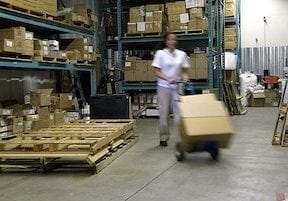“The last mile” is now the Holy Grail of ecommerce shipping. A merchant can do an amazing job of selling and provide an outstanding shopping experience, yet if the package is late or damaged, a customer may complain on social media, even if the carrier is to blame.
You can’t directly control the last mile — i.e., the distance from a local transportation hub to the final destination — but you can improve the communication with your customer to provide excellent service, even when things go wrong.
Here are five ways that merchants can provide an outstanding delivery experience and produce a positive brand impression.
5 Ways to Improve the Parcel Delivery Experience
1. Avoid porch pirates. Porch pirates are thieves that steal parcels from recipients’ porches. Many articles have been written about how to prevent this type of theft. Ideas include security cameras, lockers, and services like Package Guard, which notifies a recipient when a package is delivered.
But the most foolproof way to avoid theft is to ensure that the customer is home when the parcel arrives. Retailers can schedule delivery times and provide frequent delivery notifications (see 3., below), so consumers know when to be home. Saturday delivery options provide even more opportunities to stop package theft.
2. Provide delivery windows, with options. Customers expect tight delivery windows — ideally, 8 a.m. to 12 p.m. on a specific day, with notification an hour or so before delivery. Provide the ability for your customers to choose a delivery date and, if possible, a time.
Even better, empower them with different ways to receive packages. For example, Jet.com is installing Latch, a sophisticated access system, in 1,000 New York City apartment buildings for easier deliveries. Residents can use their phone as a key, grant access to guests without walking downstairs, and get packages delivered safely without being home.
Also, Amazon Locker is available to merchants using Fulfillment by Amazon. It is similar to a post office box, but only for Amazon deliveries. Customers get an email as soon as the package arrives at the locker and they have three days to pick it up. Similar services include FedEx Ship&Get, USPS Gopost, and UPS Access Point lockers.
Amazon is also testing delivering directly to customers’ car trunks, while Walmart is testing deliveries straight to customers’ refrigerators. Commitment to improving the last mile experience is immense. Independent merchants should not be too far behind.
3. Send frequent delivery notifications via preferred mediums. Customers have their own preferred forms of communication. The more choices they have, the more likely they are to receive and read your updates. The top three consumer choices for communication are typically email, text message, and a company order-tracking page. As a start, offer all three.
Customers appreciate being notified when an order is going to ship, when it has shipped, where the item is currently located, and ongoing updates about the expected delivery date and time.
There are plenty of exceptions to these typical notices. You’ll earn loyalty points with your customers if you handle them well, and proactively. Examples include:
- Attempted delivery by the carrier, without success.
- Available for pickup at a carrier location, after too many attempted deliveries.
- Cannot schedule a delivery appointment, and the carrier is unable to reach the customer.
- Consignee refused delivery, usually because it was delivered to the wrong address.
- Other exceptions, including expected delays, package held at terminal, and incorrect address.
4. Provide a branded tracking page. A branded delivery-tracking page is a must have. Customers become increasingly engaged with your brand during the period between the purchase and delivery. According to the 2017 “Post-Purchase Benchmark Report” from Navar, a customer loyalty and retention platform:
- Those who track orders visit the tracking page 3.1 times per order.
- The click rate on marketing assets that appear on a branded order-tracking page is 3-times higher than for marketing emails
A branded tracking page will curtail “Where is my order?” customer-service queries. It will also provide your marketing team with better opportunities to cross sell, up sell, and boost engagement.
5. Offer branded and eco-friendly packaging. Branded packaging is a effective way to advertise. It’s similar to a mobile billboard. Remember the first time you saw a package from Jet.com? Or the ubiquitous Echo and Prime advertisements on every Amazon box? The more eye-catching your packaging is, the more your customers and their neighbors will remember it.
Eco-friendly packaging is becoming more important, especially for millennials. One recent study found that more than 50 percent of shoppers would pay more for environmentally friendly packaging.
Execution Is Key
Parcel delivery strategies are easy to articulate, but hard to execute well. Managing delivery in the last mile requires infrastructure for order and fulfillment that can track real-time package status from origin to the customer’s doorstep and everywhere in between. That information must sync with numerous platforms — website, customer support, email, text messages — and accommodate order and delivery modifications. Get it all right and you’ll have an unfair competitive advantage.




